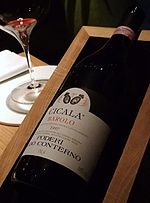Castiglione Falletto
Cities and towns in PiedmontMunicipalities of the Province of CuneoPages with Italian IPAProvince of Cuneo geography stubs

Castiglione Falletto (Italian pronunciation: [kastiʎˈʎoːne falˈletto]) is a comune (municipality) in the Province of Cuneo in the Italian region Piedmont, located about 50 kilometres (31 mi) southeast of Turin and about 40 kilometres (25 mi) northeast of Cuneo. Castiglione Falletto borders the following municipalities: Alba, Barolo, La Morra, Monforte d'Alba, and Serralunga d'Alba.
Excerpt from the Wikipedia article Castiglione Falletto (License: CC BY-SA 3.0, Authors, Images).Castiglione Falletto
Via Alba,
Geographical coordinates (GPS) Address Nearby Places Show on map
Geographical coordinates (GPS)
| Latitude | Longitude |
|---|---|
| N 44.616666666667 ° | E 7.9666666666667 ° |
Address
Via Alba
Via Alba
12065
Piedmont, Italy
Open on Google Maps








